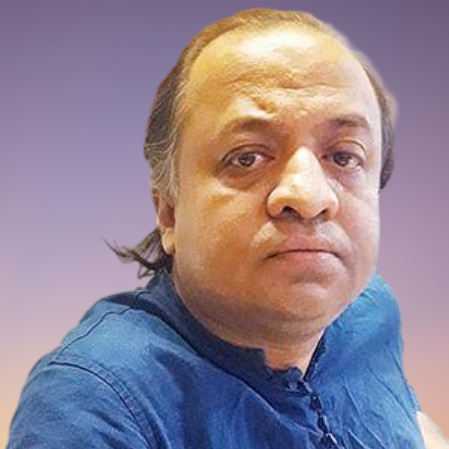Culture

Samarjit Roy Chowdhury
Samarjit Roy Chowdhury, a painter who had made his start in the 60s, and is known for his urban-folk tendencies, relentlessly dabbles in the recurring motifs of birds, kites, flowers, boats and fishes -which he transfigures into geometric patterns, bringing to these oft-used motifs a new expressionistic valence. His immense contribution to Bangladeshi art particularly folk painting, has earned him national and international acclaim. The USP of Samarjit's paintings is an in-depth observation of rural Bengal and folk life - simple harmonic patterns, rural motifs, a tranquil ambiance and childhood nostalgia. The painter did a lot of research into past times, and he really loves history as well as traditional culture.
Samarjit Roy Chowdhury has carved a niche for himself with his hallmark style. His paintings are a deep cognizance of pastoral Bengal and folk life - pastoral designs, serene atmospheres and personal reminiscences of early days. The painter feels that reminiscence has a great link with his creative life. He likes to incorporate many elements in his work. He has tried to blend a modern approach with his folk based works.
However, in his early days, Samarjit was preoccupied with the pictorial aspect of life, bringing in motifs like birds, fishes, boats and human being early years. These assembled impetus over the year. His center of attention changed from the tangible reality to a kaleidoscopic inner meaning of nature. His form s and treatment of colours remain intense. His concern for folk motifs and decorative patterns spread his message all over the canvas. In his paintings, the discovery of chiaroscuro (pictorial representation in terms of light and shade without regard to colour) led to create lyrical and dramatic compositions. He has used circles, rectangles, squares and so on. He considers these as part of the environment. Squares and rectangles are scattered throughout his paintings. In his latest work vertical lines play an important role.
In recent times, the painter has sought to blend a modern approach with his folk-based works. His recurring motifs are birds, kites, leaves, wild flowers, boats, plants and fish. Scribbles and thick lines crisscross over his paintings. His lines are not polished at all. The uneven lines create an individual language, highlighting a rural essence. The painter has tried to capture the lively moments of the rural Bengal. Village festivities, villagers' joys and despair, rural life and its varied aspects have always fascinated him.
Samarjit draws inspiration from indigenous objects such as Lokkhi-shora and pata-chitra. He was also inspired by his teacher Guvenshar Chokroborty from Kolkata, his maternal uncle, Jyotindra Kar, a sculptor on wood and his mother who did fine embroidery, bringing in motifs of flora and fauna. At the Art College in Dhaka (now the Faculty of Fine Arts, University of Dhaka) he learnt from Zainul Abedin, Quamrul Hassan, Anwarul Huq, Mohammed Kibria and Safiuddin Ahmed.
Samarjit's lines and colours are also motivated by clay dolls and ancient ballads. His works present a combination of traditional and modern geometric, abstract forms. Adroit application of light and shades are evident. Besides restless curves, geometric forms, rectangular-triangular and broken lines make his images noteworthy. Playing with forms is Samarjit's forte. Among the avant-garde second generation of contemporary artists in Bangladesh, Samajit seeks to represent our culture, heritage and traditions. As a painter, he believes he has certain responsibilities to the motherland.
It has been very noticeable that his subjects are taken from scenes around him. The diversity of colours of birds and trees have always fascinated him and have found expression his work. Figures of village women have also been part of his repertoire of folk motifs. He blends what he sees around him with the folk motifs of Laksmi-shora and other forms of local painted pottery of rural Bangladesh. These are painted over with the primary colours of red, blue and yellow, which he introduces repeatedly in his paintings. Fishing nets also recur on his canvases as it is an integral part of our riverine life. Samarjit has used acrylic, oil, mixed media in his paintings and watercolour. He has also done woodcuts and etchings in his chequered career.
Born in 1937 in Comilla, he graduated in Graphic Design from the Government Art Institute (presently Faculty of Fine Art, Dhaka University) in 1960. There he was guided by Zainul Abedin, Quamrul Hassan, Anwarul Huq, Mohammed Kibria and Safiuddin Ahmed. Samarjit also taught at the same institution for a long 43 years. Following his retirement, he joined the Shanto Mariam University of Creative Design as Dean of the Department of Fine and Performing Arts where he worked till 2010. He also served as supernumerary professor at the University of Dhaka.
The painter has held seven solo exhibitions. Samarjit has received the Ekushey Padak, Shilpakala Padak and Sultan Padak for his outstanding contributions to Bangladeshi art. A recipient of several prestigious awards, he has taken part in over 220 group exhibitions in the country and abroad.

























Leave a Comment
Recent Posts
The forensic clean up of the f ...
Much of the coverage centring the surge in Non Performing Loans (NPLs) ...
Hong Kong’s deadliest fire in ...
Hong Kong’s deadliest fire in decades left at least 44 people de ...
False document submission hurts genuine students’ ch ..
The Missing Ingredients for Peace in Palestine
Songs of Hyacinth Boats & Hands: Reading Conversatio ..
Executive Editor Julie Pace on why AP is standing fo ..